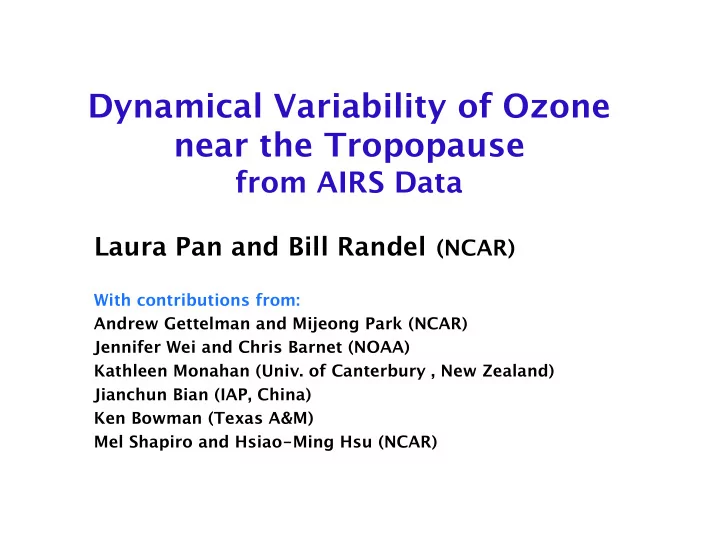

Dynamical Variability of Ozone near the Tropopause from AIRS Data Laura Pan and Bill Randel (NCAR) With contributions from: Andrew Gettelman and Mijeong Park (NCAR) Jennifer Wei and Chris Barnet (NOAA) Kathleen Monahan (Univ. of Canterbury , New Zealand) Jianchun Bian (IAP, China) Ken Bowman (Texas A&M) Mel Shapiro and Hsiao-Ming Hsu (NCAR)
AIRS Ozone Data • Continue to show impressive consistency with dynamics of the UTLS - case 5 • Validation study continues - – Using ozonesonde data – Using aircraft data (MOZIAC) • Dynamical variability - Preferred locations of Stratosphere to troposphere transport (STT) of ozone
Case 5: Stratospheric Intrusion during a Dust Storm In collaboration with Mel Shapiro and Hsiao-ming Hsu
Dust
Rossby Wave-Train Ray Path 50 N. EQUATOR
PV from NCAR WRF/ARW model and AIRS Ozone, March 4th, 2004
Wind Speed (m s-1);Theta (K) Potental Vorticity 8 km (PVU) Tropopause Fold 30 ms-1 2 PVU A A B B
Ozone from AIRS on NASA Aqua Satellite
PV from NCAR WRF model and AIRS Ozone cross section
3D ozone structure near the tropopause from AIRS - if validated, it will provide unprecedented opportunities for quantitative studies of STE We need to understand where the retrieval information is from
More Validation Studies • For our own validation studies, we have compared AIRS ozone with ozonesondes and aircraft data (HIAPER and MOZAIC). • The comparisons shown here use AIRS v4 retrievals, gridded to daily grids with 1x1 degree resolution • Ozonesondes profiles are taken from the WOUDC archive • MOZAIC comparisons are in an early stage (preliminary results here)
There are examples of excellence agreement between AIRS ozone profiles and ozonesondes. (200hPa ozone, using 442 soundings during 2003-2005) Payerne, Switzerland (47N)
AIRS – ozonesonde correlations at 9 stations: Station # Boulder 122 Payerne 442 Sapporo 128 Tateno 149 Edmonton 104 Goosebay 84 Churchill 75 Resolute 46 Lauder 135 high correlations at each station over ~100 – 300 hPa
AIRS – ozonesonde correlations and biases (9 stations, 2003-2005) small AIRS low bias significant AIRS high bias below ~ 250 hPa
Beijing Ozonesonde comparisons [Bian et al., 2006]
We have found an asymmetry between NH and SH retrievals - there is a larger (high) bias in SH tropospheric ozone values. The reason for this bias is likely associated with the bias in ECMWF A Priori
MOZAIC flight map (05/2003) 160 flights this month
AIRS O 3 vs. MOZAIC flights for one day 1 2
AIRS vs. MOZAIC O 3 profiles AIRS 1 MOZAIC 2
Time vs. altitude sections curtain from AIRS 1 MOZAIC measurements 2
Overall comparisons suggest that AIRS v4 ozone is quite reasonable for levels ~300-100 hPa. We anticipate using AIRS ozone to study space-time variability of the tropopause and UTLS transport large wave-breaking event near tropopause
Lagrangian Models - preferred locations ERA15 climatology: STT Winter vs. summer Sprenger and Wernli 2003 (JGR)
HIAPER Progressive Science Mission Stratosphere-Troposphere Analyses of Stratosphere-Troposphere Analyses of Regional Transport (START) Experiment Regional Transport (START) Experiment (December 2005) Daybreak before take off 2005-12-21
Tropopause Fold Sampled by HIAPER First research flight of HIAPER, 2005-12-01 Stratosphere Troposphere The yellow surface represents dynamical tropopause (2 PVU) from NCEP GFS analyses. HIAPER flight track is colored by in situ ozone values
Separation of the Thermal and Dynamical Tropopause and Mixing
Origins and the fate of the airmass inside the intrusion ( 3 days backward and forward trajectories of the air parcels in the fold)
Preferred STE location in NH by AIRS, May 1-9, 2005
Preferred STE location in NH by AIRS, monthly mean May 2005 Dynamical Tropopause (2PVU) Ozone tropopause (oztp=120 ppbv)
Summary • AIRS v4 ozone show significant correlation with sondes between 300-50 hPa range, with the best accuracy near the extratropical tropopause. • Significant high bias in the mid troposphere and a small low bias in the lower stratosphere. • Current ozone data is very valuable for characterizing the dynamical variability of the ozone in the extratropical UTLS, including stratosphere troposphere exchange. • How well the data can be used to study deep stratospheric intrusion into troposphere and transport in the troposphere is uncertain. • An improved characterization of retrieval information content is highly desirable.
Thank You!
Stratosphere Stratospheric tracer “depth” Troposphere Tropospheric tracer Lower boundary of the mixing
Recommend
More recommend